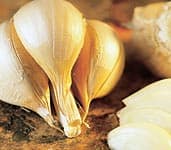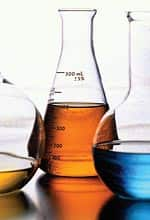Life Extension Magazine®
Herbalists routinely claim that garlic (Allium sativum) is the world’s longest-used medicinal food. The therapeutic use of garlic predates written history by several millennia, with the earliest mention dating back more than 5,000 years ago to Sanskrit records in India.1 Garlic was already a long-favored remedy in ancient medicine 1,000 years before the birth of Christ. Ancient Egyptians worshipped the spice as a god, valuing it so much that 15 pounds of garlic would purchase a healthy male slave. A close relative of the onion, garlic’s origins in the Kirgiz desert region of Siberia have endowed it with the ability to thrive in harsh climates and poor soil. The bulb’s adaptability played a significant role in its becoming a staple crop in almost every civilization around the globe. Even 1,000 years ago, garlic was grown in virtually all the known world and nearly universally recognized as a medicinal plant. Twentieth-century science relegated garlic to a state of relative neglect medicinally, if not in the kitchen. In recent years, however, garlic has moved to the forefront of an explosion of interest in natural remedies. According to the UCLA Center for Human Nutrition in Los Angeles, diets rich in plant foods are associated with a reduced risk of heart disease and cancer. These plant foods contain phytochemicals that have anti-cancer and anti-inflammatory properties. Garlic and other white-green foods in the onion family contain allyl sulphides, which may inhibit the growth of cancer cells.2 Today, garlic is the subject of considerable research for its medicinal properties, and new clinical trials are yielding proof of its role as a powerful antioxidant. Garlic also shows promise in protecting against heart disease, hypertension, and cancer. Scavenging Free RadicalsImplicated in many serious illnesses, free radicals are harmful byproducts of cellular metabolism. Antioxidants scavenge free radicals. Sulfur-containing compounds, found in all body cells, are indispensable to living organisms. Unlike humans, plants can use inorganic sulfur to synthesize sulfur-containing amino acids. Many strong antioxidant compounds are rich in sulfur, including N-acetylcysteine, taurine, lipoic acid, and glutathione. Plants are an important source of sulfur for humans, and garlic is a major source of organosulfur compounds.3 Recent studies in India have demonstrated garlic’s effectiveness in reducing oxidative stress in animals with high blood lipid levels. Supplementation with garlic significantly countered the lipid-related depletion of intracellular antioxidants in the liver and red blood cells.4,5 Two separate studies focused on S-allylcysteine, a garlic-derived compound and well-characterized scavenger of free radicals. S-allylcysteine scavenges free radicals and reduces oxidative stress.6,7 In experimental animal models, S-allylcysteine helped protect the nervous system from neurotoxins and the kidneys against damage from reactive oxygen species.6,7 Protecting the HeartIn horror movies, garlic is often used to ward off vampires. Garlic does indeed protect the blood (and its major engine, the heart) from attack—not from vampires, but from a subtler enemy. In recent years, atherosclerosis has emerged as one of the leading causes of death in nations whose diets are disproportionately high in saturated fats and cholesterol. A Czech study investigated garlic’s inhibitory effect on the biosynthesis of cholesterol and fatty acids. Positive results manifested in reduced arterial plaque and markedly decreased accumulation of cholesterol in the vascular walls.8
A Turkish team exploring garlic extract’s effects on coronary plaque formation saw similar results. In test animals, seven months of garlic supplementation significantly decreased the plaque surface area in the animals’ aortas.9 Another study implicated several sulfur-containing compounds isolated from garlic as highly active anti-thrombotic agents. This study established that garlic could be a significant inhibitor of platelet aggregation.10 Eleven patients with atherosclerosis were the focus of a six-month study on possible beneficial effects of garlic extract at a daily dose of 1 milliliter per kilogram of body weight. Garlic supplementation notably lowered levels of the oxidative marker malondialdehyde in plasma and red blood cells; ingesting garlic extract also prevented oxidation reactions by eliminating oxidant stress.11 The study authors concluded, “it is possible that reduced peroxidation processes may play a part in some of the beneficial effects of garlic in atherosclerotic diseases.”11 Aged garlic extract has been shown to reduce multiple cardiovascular risk factors, including blood pressure, cholesterol, and platelet aggregation and adhesion, while stimulating the generation of nitric oxide in endothelial cells.12 A recent, double-blind, placebo-controlled study evaluated aged garlic extract’s ability to inhibit vascular calcification, a marker of plaque formation in human coronary arteries, in 23 patients with atherosclerosis.12 The results suggested that aged garlic extract may inhibit the progression of coronary calcification, suggesting a therapeutic role for garlic in patients at high risk for future cardiovascular events.12 Taking the Pressure OffHypertension, or high blood pressure, is a silent but potentially deadly disease. Research suggests that garlic supplementation may provide important benefits for hypertensive patients. Researchers at the University of Mississippi investigated hypertension treatment using natural, commonly available dietary supplements and stress-reducing lifestyle modifications.13 Garlic showed the potential to reduce systolic blood pressure by at least 9 mmHg and diastolic blood pressure by at least 5 mmHg.13 A subsequent Turkish clinical trial took this evidence further, finding that garlic extract supplementation over four months markedly lowered systolic and diastolic blood pressure values in hypertensive volunteer subjects with high blood cholesterol.14 In those with normal blood pressure, garlic did not affect blood pressure levels.14
Ally in the Cancer WarFor thousands of years, traditional medical practitioners have used garlic and other members of the Allium genus to treat cardiovascular disease.15 Garlic’s use as a remedy for tumors extends back to the Codex Ebers of 1550 BC, an Egyptian medical papyrus.16 Recent extensive research has focused on the anticarcinogenic potential of allium vegetables and their constituents, allylsulfides (organosulfur compounds) and flavonoids. Modern epidemiological studies, well correlated with laboratory investigations, corroborate the evidence that higher intake of allium products is associated with reduced risk of several cancers.15 The mechanisms proposed to explain the cancer-preventive effects of garlic include inhibition of tumor mutagenesis, modulation of enzyme activities, and effects on cell proliferation and tumor growth.15 Several garlic compounds, including allicin, induce apoptosis (programmed cell death) in various malignant human cells. These include breast, colorectal, hepatic, prostate, and lymphoma cells.16 A growing number of clinical studies are examining the properties of ajoene, the major sulfur-containing compound purified from garlic. Ajoene has the advantage of being more chemically stable than allicin, and researchers are investigating its possible role in the prevention and treatment of cancer.17,18 Cancer researchers have noted that inhibition of the proteasome—an intracellular device by which damaged or unneeded proteins are broken down—plays a key role in apoptosis and cell cycle blockade in tumor cells. In a recent French study of ajoene’s effects on the proteasome’s activities, researchers found that ajoene affected proteasome function and activity both in vitro and in the living cell, and that these effects may account for ajoene’s potential anti-tumor action.19 Topical application of ajoene has produced significant clinical response in patients with skin basal cell carcinoma.16 Ajoene inhibited proliferation and induced apoptosis of human leukemia CD34-negative cells, inducing 30% apoptosis in myeloblasts from a chronic myeloid leukemia patient in blast crisis.16 Even more significantly, ajoene profoundly enhanced the apoptotic effect of two chemo-therapeutic drugs, cytarabine (Cytosar®) and fludarabine (Fludara®).16 The list of cancers responding to garlic treatment or supplementation continues to grow. Separate Chinese studies reported that the garlic component allyl sulfide demonstrated activity against human bladder cancer20 and liver cancer21 cells in vitro. Another study reported on the protective effects of garlic components in a rat model of colon carcinogenesis, noting that garlic inhibited cell proliferation, induced apoptosis, and suppressed the activity of the cyclooxygenase-2 (COX-2) enzyme.22 Getting the BenefitsGarlic has demonstrated few toxic side effects. While eating garlic cloves is a proven way to obtain the benefits of their organosulfides, unwelcome side effects include bad breath and perspiration. Fortunately, garlic supplements provide all the benefits of eating raw garlic without these undesirable effects. | |||
| References | |||
| 1. Riddle JM. Garlic’s history as a medicine. Paper presented at: American Herbal Products Association International Garlic Symposium; July 31, 2001. 2. Heber D. Vegetables, fruits and phyto-estrogens in the prevention of diseases. J Postgrad Med. 2004 Apr;50(2):145-9. 3. Atmaca G. Antioxidant effects of sulfur-containing amino acids. Yonsei Med J. 2004 Oct 31;45(5):776-88. 4. Kempaiah RK, Srinivasan K. Influence of dietary curcumin, capsaicin and garlic on the antioxidant status of red blood cells and the liver in high-fat-fed rats. Ann Nutr Metab. 2004 September ;48(5):314-20. 5. Kempaiah RK, Srinivasan K. Antioxidant status of red blood cells and liver in hypercholesterolemic rats fed hypolipidemic spices. Int J Vitam Nutr Res. 2004 May;74(3):199-208. 6. Perez-Severiano F, Rodriguez-Perez M, Pedraza-Chaverri J, et al. S-Allylcysteine, a garlic-derived antioxidant, ameliorates quinolinic acid-induced neurotoxicity and oxidative damage in rats. Neurochem Int. 2004 Dec;45(8):1175-83. 7. Maldonado PD, Barrera D, Rivero I, et al. Antioxidant S-allylcysteine prevents gentamicin-induced oxidative stress and renal damage. Free Radic Biol Med. 2003 Aug 1;35(3):317-24. 8. Sovova M, Sova P. Pharmaceutical importance of Allium sativum L. 5. Hypolipemic effects in vitro and in vivo. Ceska Slov Farm. 2004 May;53(3):117-23. 9. Durak A, Ozturk HS, Olcay E, Guven C. Effects of garlic extract supplementation on blood lipid and antioxidant parameters and atherosclerotic plaque formation process in cholesterol-fed rabbits. J Herb Pharmcother. 2002;2(2):19-32. 10. Budoff MJ, Takasu J, Flores FR, et al. Inhibiting progression of coronary calcification using aged garlic extract in patients receiving statin therapy: a preliminary study. Prev Med. 2004 Nov;39(5):985-91. 11. Wilburn AJ, King DS, Glisson J, Rockhold RW, Wofford MR. The natural treatment of hypertension. J Clin Hypertens.(Greenwich.) 2004 May;6(5):242-8. 12. Durak I, Kavutcu M, Aytac B, et al. Effects of garlic extract consumption on blood lipid and oxidant/antioxidant parameters in humans with high blood cholesterol. J Nutr Biochem. 2004 Jun;15(6):373-7. 13. Sengupta A, Ghosh S, Bhattacharjee S. Allium vegetables in cancer prevention: an overview. Asian Pac J Cancer Prev. 2004 Jul;5(3):237-45. 14. Hassan HT. Ajoene (natural garlic compound): a new anti-leukaemia agent for AML therapy. Leuk Res. 2004 Jul;28(7):667-71. 15. Ledezma E, Apitz-Castro R, Cardier J. Apoptotic and anti-adhesion effect of ajoene, a garlic derived compound, on the murine melanoma B16F10 cells: possible role of caspase-3 and the alpha(4)beta(1) integrin. Cancer Lett. 2004 Mar 31;206(1):35-41. 16. Tilli CM, Stavast-Kooy AJ, Vuerstaek JD, et al. The garlic-derived organosulfur component ajoene decreases basal cell carcinoma tumor size by inducing apoptosis. Arch Dermatol Res. 2003 Jul;295(3):117-23. 17. Xu B, Monsarrat B, Gairin JE, Girbal-Neuhauser E. Effect of ajoene, a natural antitumor small molecule, on human 20S proteasome activity in vitro and in human leukemic HL60 cells. Fundam Clin Pharmacol. 2004 Apr;18(2):171-80. 18. Lu HF, Sue CC, Yu CS, et al. Diallyl disulfide (DADS) induced apoptosis undergo caspase-3 activity in human bladder cancer T24 cells. Food Chem Toxicol. 2004 Oct;42(10):1543-52. 19. Wu CC, Chung JG, Tsai SJ, Yang JH, Sheen LY. Differential effects of allyl sulfides from garlic essential oil on cell cycle regulation in human liver tumor cells. Food Chem Toxicol. 2004 Dec;42(12):1937-47. 20. Sengupta A, Ghosh S, Bhattacharjee S, Das S. Indian food ingredients and cancer prevention - an experimental evaluation of anticarcinogenic effects of garlic in rat colon. Asian Pac J Cancer Prev. 2004 Apr;5(2):126-32. 21. Zlotogorski HA, Littner M. Potential risks, adverse effects and drug interactions associated with herbal medicine in dental patients. Refuat Hapeh Vehashinayim. 2004 Apr;21(2):25-41, 97. 22. Ciocon JO, Ciocon DG, Galindo DJ. Dietary supplements in primary care. Botanicals can affect surgical outcomes and follow-up. Geriatrics. 2004 Sep;59(9):20-4. |



